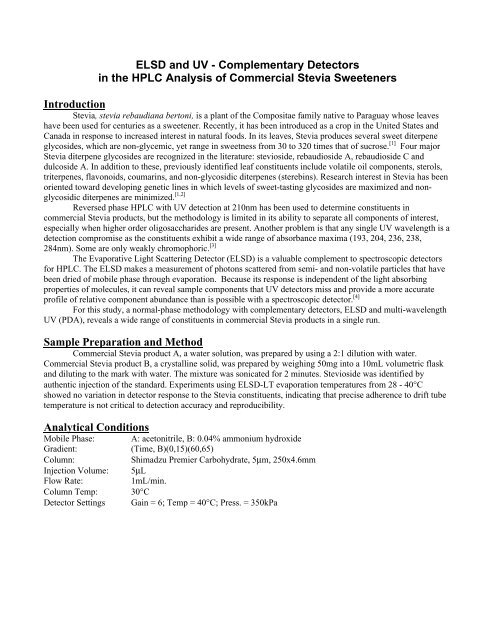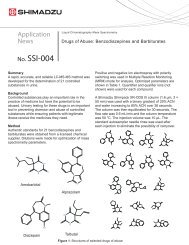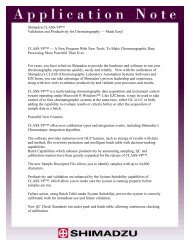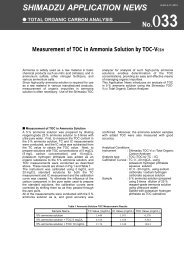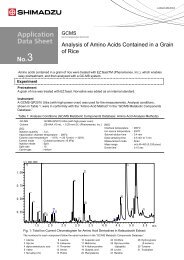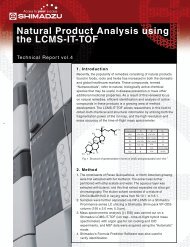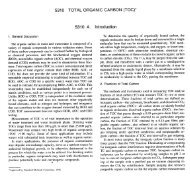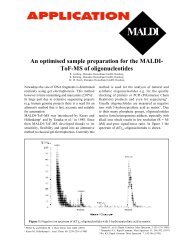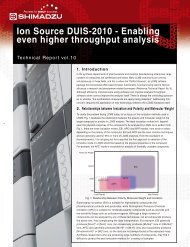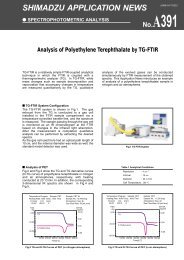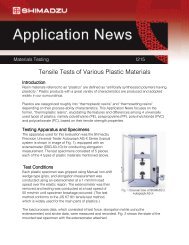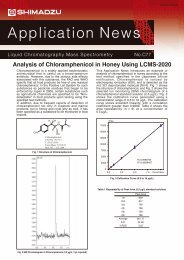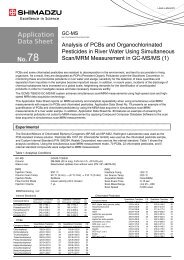ELSD and UV - Complementary Detectors in the HPLC ... - Shimadzu
ELSD and UV - Complementary Detectors in the HPLC ... - Shimadzu
ELSD and UV - Complementary Detectors in the HPLC ... - Shimadzu
You also want an ePaper? Increase the reach of your titles
YUMPU automatically turns print PDFs into web optimized ePapers that Google loves.
<strong>ELSD</strong> <strong>and</strong> <strong>UV</strong> - <strong>Complementary</strong> <strong>Detectors</strong><strong>in</strong> <strong>the</strong> <strong>HPLC</strong> Analysis of Commercial Stevia SweetenersIntroductionStevia, stevia rebaudiana bertoni, is a plant of <strong>the</strong> Compositae family native to Paraguay whose leaveshave been used for centuries as a sweetener. Recently, it has been <strong>in</strong>troduced as a crop <strong>in</strong> <strong>the</strong> United States <strong>and</strong>Canada <strong>in</strong> response to <strong>in</strong>creased <strong>in</strong>terest <strong>in</strong> natural foods. In its leaves, Stevia produces several sweet diterpeneglycosides, which are non-glycemic, yet range <strong>in</strong> sweetness from 30 to 320 times that of sucrose. [1] Four majorStevia diterpene glycosides are recognized <strong>in</strong> <strong>the</strong> literature: stevioside, rebaudioside A, rebaudioside C <strong>and</strong>dulcoside A. In addition to <strong>the</strong>se, previously identified leaf constituents <strong>in</strong>clude volatile oil components, sterols,triterpenes, flavonoids, coumar<strong>in</strong>s, <strong>and</strong> non-glycosidic diterpenes (stereb<strong>in</strong>s). Research <strong>in</strong>terest <strong>in</strong> Stevia has beenoriented toward develop<strong>in</strong>g genetic l<strong>in</strong>es <strong>in</strong> which levels of sweet-tast<strong>in</strong>g glycosides are maximized <strong>and</strong> nonglycosidicditerpenes are m<strong>in</strong>imized. [1,2]Reversed phase <strong>HPLC</strong> with <strong>UV</strong> detection at 210nm has been used to determ<strong>in</strong>e constituents <strong>in</strong>commercial Stevia products, but <strong>the</strong> methodology is limited <strong>in</strong> its ability to separate all components of <strong>in</strong>terest,especially when higher order oligosaccharides are present. Ano<strong>the</strong>r problem is that any s<strong>in</strong>gle <strong>UV</strong> wavelength is adetection compromise as <strong>the</strong> constituents exhibit a wide range of absorbance maxima (193, 204, 236, 238,284nm). Some are only weakly chromophoric. [3]The Evaporative Light Scatter<strong>in</strong>g Detector (<strong>ELSD</strong>) is a valuable complement to spectroscopic detectorsfor <strong>HPLC</strong>. The <strong>ELSD</strong> makes a measurement of photons scattered from semi- <strong>and</strong> non-volatile particles that havebeen dried of mobile phase through evaporation. Because its response is <strong>in</strong>dependent of <strong>the</strong> light absorb<strong>in</strong>gproperties of molecules, it can reveal sample components that <strong>UV</strong> detectors miss <strong>and</strong> provide a more accurateprofile of relative component abundance than is possible with a spectroscopic detector. [4]For this study, a normal-phase methodology with complementary detectors, <strong>ELSD</strong> <strong>and</strong> multi-wavelength<strong>UV</strong> (PDA), reveals a wide range of constituents <strong>in</strong> commercial Stevia products <strong>in</strong> a s<strong>in</strong>gle run.Sample Preparation <strong>and</strong> MethodCommercial Stevia product A, a water solution, was prepared by us<strong>in</strong>g a 2:1 dilution with water.Commercial Stevia product B, a crystall<strong>in</strong>e solid, was prepared by weigh<strong>in</strong>g 50mg <strong>in</strong>to a 10mL volumetric flask<strong>and</strong> dilut<strong>in</strong>g to <strong>the</strong> mark with water. The mixture was sonicated for 2 m<strong>in</strong>utes. Stevioside was identified byau<strong>the</strong>ntic <strong>in</strong>jection of <strong>the</strong> st<strong>and</strong>ard. Experiments us<strong>in</strong>g <strong>ELSD</strong>-LT evaporation temperatures from 28 - 40°Cshowed no variation <strong>in</strong> detector response to <strong>the</strong> Stevia constituents, <strong>in</strong>dicat<strong>in</strong>g that precise adherence to drift tubetemperature is not critical to detection accuracy <strong>and</strong> reproducibility.Analytical ConditionsMobile Phase: A: acetonitrile, B: 0.04% ammonium hydroxideGradient:(Time, B)(0,15)(60,65)Column:<strong>Shimadzu</strong> Premier Carbohydrate, 5µm, 250x4.6mmInjection Volume: 5µLFlow Rate:1mL/m<strong>in</strong>.Column Temp: 30°CDetector Sett<strong>in</strong>gs Ga<strong>in</strong> = 6; Temp = 40°C; Press. = 350kPa
Figure 1: Simultaneous <strong>UV</strong> (210nm) <strong>and</strong> <strong>ELSD</strong>-LT chromatograms obta<strong>in</strong>ed for commercial Stevia product Bconta<strong>in</strong><strong>in</strong>g erythritol, Steviol glycosides <strong>and</strong> <strong>in</strong>ul<strong>in</strong> oligosaccharides.Figure 2: <strong>ELSD</strong>-LT chromatograms obta<strong>in</strong>ed for commercial Stevia products, A <strong>and</strong> B.
Figure 3: <strong>ELSD</strong>-LT chromatogram of diterpenes, diterpene glycosides <strong>and</strong> non-diterpene glycosides obta<strong>in</strong>ed forcommercial Stevia product A.Results <strong>and</strong> ConclusionAs shown <strong>in</strong> Figure 1 <strong>and</strong> consistent with <strong>the</strong> literature, <strong>UV</strong> detection at 210nm reveals <strong>the</strong> pr<strong>in</strong>cipalStevia diterpene glycosides for commercial Stevia product B. The <strong>ELSD</strong>-LT, on <strong>the</strong> o<strong>the</strong>r h<strong>and</strong>, reveals acomplex mixture of chromophoric <strong>and</strong> non-chromophoric constituents <strong>in</strong> addition to <strong>the</strong> Stevia diterpeneglycosides. The commercial additives erythritol <strong>and</strong> <strong>in</strong>ul<strong>in</strong> fructo-oligosaccharides (FOS) are consistent with <strong>the</strong>label claim. Erythritol <strong>and</strong> Dulcoside are co-elut<strong>in</strong>g under <strong>the</strong>se chromatographic conditions, <strong>the</strong> erythritol be<strong>in</strong>gdetected by <strong>ELSD</strong> alone. When compared to low <strong>UV</strong> wavelengths, it is clear that <strong>the</strong> <strong>ELSD</strong>-LT delivers betterbasel<strong>in</strong>e response for <strong>the</strong> gradient elution. Figure 2 shows comparison <strong>ELSD</strong>-LT profiles for <strong>the</strong> pr<strong>in</strong>cipal Steviaconstituents of products A <strong>and</strong> B.The <strong>ELSD</strong>-LT reveals diterpenes, diterpene glycosides <strong>and</strong> non-terpenoid glycosides for Stevia product A<strong>in</strong> one run with a more accurate representation of constituent relative abundance. This is readily seen <strong>in</strong> Figure 3.Many of <strong>the</strong> m<strong>in</strong>or constituents are weakly or non-chromophoric, mak<strong>in</strong>g <strong>UV</strong> detection alone problematic when<strong>the</strong> analyst is <strong>in</strong>terested <strong>in</strong> more than <strong>the</strong> Steviol glycosides alone. Table 1 shows peak assignment <strong>and</strong> area %data for <strong>the</strong> Steviol glycosides of product A accord<strong>in</strong>g to <strong>ELSD</strong> response. The % relative abundance of Steviolglycosides as determ<strong>in</strong>ed by <strong>ELSD</strong> data is consistent with <strong>the</strong> literature. [1,2]
Table 1RetentionTime, <strong>ELSD</strong>(m<strong>in</strong>.)<strong>UV</strong> lmax,PDA (nm)Constituent Class Peak Assignment Area %Steviolglycosides2.7 236, 282 diterpene (stereb<strong>in</strong>)2.9 229 diterpene (stereb<strong>in</strong>)3.1 238, 282 diterpene (stereb<strong>in</strong>)4.5 193 unknown glycoside8.0 193 unknown glycoside10.6 193 unknown glycoside Dulcoside 0.7810.9 193 unknown glycoside11.5 193 unknown glycoside12.7 197 diterpene glycoside Stevioside 68.6413.8 193 diterpene glycoside Rebaudioside C 5.5414.4 193 unknown glycoside15.9 195 diterpene glycoside Rebaudioside A 25.0416.5 193 unknown glycoside18.2 193 unknown glycoside20.7 193 unknown glycosideFrom <strong>the</strong> data, <strong>ELSD</strong> <strong>and</strong> multi-wavelength <strong>UV</strong> detection complement one ano<strong>the</strong>r for <strong>the</strong> determ<strong>in</strong>ation ofcommercial Stevia product constituents. While <strong>the</strong> four Steviol glycosides may be determ<strong>in</strong>ed by low-wavelength<strong>UV</strong> alone, <strong>the</strong> myriad of Stevia constituents are revealed by <strong>the</strong> evaporative light scatter<strong>in</strong>g detector.References1. McGarvey, B. D., Attygalle, A. B., Starratt, A. N., Br<strong>and</strong>le, J. E., Xiang, B., Schroeder, F. C., Me<strong>in</strong>wald, J.,Sou<strong>the</strong>rn Crop Protection <strong>and</strong> Food Research Centre Poster of Research Efforts (1999).2. Br<strong>and</strong>le, J. E., Starratt, A. N., Gijzen, M. Can. J. Plant Sci. 78, 527 – 536 (1998).3. Semma, M., Fujii, M., Okada, Y., Kataoka, H., Ito, Y., Jpn. J. Food Chem., 8(2), 2001.4. Young, C. S., Cereal Foods World., 47(1), 14-16 (2002).System Configuration*Part #Description228-39000-92 LC-10ADvp Pump (2)228-35830-91 100µL Semi-Micro Gradient Mixer228-35359-92 DGU-14A On-L<strong>in</strong>e Degasser228-41576-32 <strong>ELSD</strong>-LT Evaporative Light Scatter<strong>in</strong>g Detector228-35555-92 SPD-M10Avp Photodiode Array Detector228-34350-92 SCL-10Avp System Controller223-03507-91 PC-55N A/D option board for SCL228-34611-92 CTO-10ACvp Column Oven228-39005-92 SIL-10Avp Autosampler220-91262-00 W<strong>in</strong>dows® 2000 Data Station <strong>and</strong> CLASS-VP 7.x software*O<strong>the</strong>r options are available. Ask your Sales Representative for a system that’s right for you.


